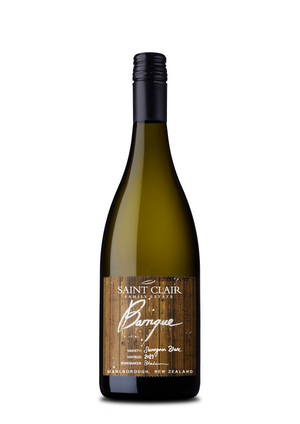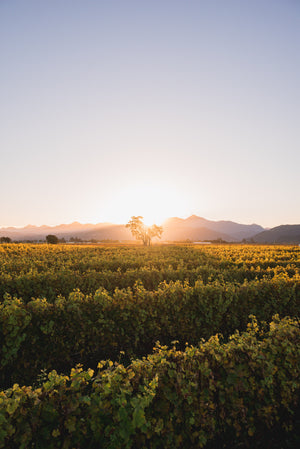
At a function in Christchurch Neal and Judy Ibbotson founders of Saint Clair Family Estate were inducted as fellows of New Zealand Winegrowers. Sophie Preece, from the New Zealand Winegrowers magazine, recently interviewed Neal and Judy to delve into the story of their humble beginnings and the incredible journey that led to their remarkable success.
Neal and Judy Ibbotson: From swine to vine to wine
When Judy and Neal Ibbotson met in the late 1960s, he was a farm adviser, she was a dental nurse, and they were each dating the other’s flatmate. “We swapped partners,” explains Neal. “It was the best thing we ever did.”
Fifty-five years on, the pioneering founders of Saint Clair Family Estate, both of them New Zealand Winegrowers Fellows for 2023, say good timing and good people have characterised their journey in wine. “The names on the accolades might be Judy and Neal, but it’s not about Judy and Neal. We are proud to receive this award on behalf of all those great people.”
In the early 1970s the Ibbotsons borrowed money to buy 13 hectares on the outskirts of Blenheim, along with 100 pigs. Judy’s father developed mobile pig sties which they dragged around the paddocks with a tractor, so that their swine got fat while fertilising the land. “Today this practice would have been called sustainable organic farming,” Neal notes.
In 1973 Montana, now Pernod Ricard, started planted vines in Marlborough, and before too long the company was looking for contract growers. Meanwhile, the price of pork had plummeted and the Ibbotsons were casting around for a more viable land use. The timing was perfect, and they joined nine other pioneering landowners in growing grapes for the company. “We were on a voyage of discovery,” says Neal, reflecting that the steep learning curve has yet to let up.
“We have been extremely fortunate to have been in the right place at the right time, surrounded by amazing people and to have been part of the Marlborough wine industry, and part of the Sauvignon Blanc phenomenon.
These days there are nearly 30,000ha of vines in Marlborough, but back then the land was dominated by dry, dusty, stony paddocks, growing sheep, crops, “and the odd orchard”, Neal says. “There were no contract labour or machinery gangs, so Judy and a team of ladies planted our first Müller Thurgau vines.”
For 13 years, Judy’s team worked during school hours, starting out with cuttings from Montana’s nursery, transported to the block in her lowlight Morris Minor, resplendent in turquois. The car was their substitute for a Range Rover, Neal says. “It didn’t have 4-wheel-drive, but it was less capital intensive and still made it up and down the rows of grape plants.”
Neal stuck with his job, but each weekend took to the vineyard, establishing vines and trellis, and loosening the soil with a post hole borer, so the “group of ladies” could plant the cuttings, “stamping the vine in three times” Judy says, recalling a lot of laughs amid a lot of hard work. “The night before our first harvest some of the ladies arrived out to celebrate witha flagon of sherry – needless to say it was a long day when the harvester actually started.” Then there was winter pruning. “An early morning job was to pull out the old wood to get us warmed up then prune and wrap and tie vines down.”
In those early days, irrigating vines was considered a ‘no-no’, as they thought it might affect wine quality, Neal says. “Then Henk Ruesink – a Dutch immigrant who became a hard-working horticulturist, then viticulturist – became the first person to introduce trickle irrigation of grape vines to Marlborough”. That was “industry changing”, with vines flourishing under the combination of free draining soils, sunshine and water, he adds. “Henk was never officially recognised for showing the way. He should have been knighted.”
Judy recalls the work that came with trickle irrigation. “A back breaking job was to lay irrigation polythene pipe and use a nail in a piece of wood to make a hole, then insert a microtube whisker. We would be crawling by the end of the row.” But the grape vines responded and they ultimately proved an easier proposition than pigs, which periodically escaped, and had to be chased down. “One neighbour thought he was a cowboy and tried using a lasso,” recalls Neal. “He was useless.”
Despite the toil they were “great days”, with a group of 10 contract growers all new to the industry, and all “thirsty for knowledge”, Neal says. “The vines were all of the Müller Thurgau variety destined for bag-in-a-box wine for the New Zealand market, and all planted on their own roots.” There were no exports back then, and in the 1980s a domestic oversupply led to the Government-funded vine pull. “As exports opened up, we replanted and changed varieties – mainly to Sauvignon Blanc.”
Their children Sarina, Tony and Julie helped in the weekends and holidays. “They were paid 20 cents per hour and still describe this as slave labour,” Neal says. But something clearly stuck, because in the decades since, Tony has led the company’s branding, while Sarina and Julie redirected their previous careers into wine marketing studies, and now manage the business. Neal and Judy say their children were all urged to leave Blenheim and find their own path. But they’re clearly delighted that that path somehow led back to the business.
Saint Clair Family Estate has come a long way since 1994, when the family came up with the company name over a Sunday roast on a cold winter’s night. “Following a couple of wines and some hokey pokey ice cream, discussion took place regarding the all-important brand name to be given to the new wine in the tank,” Judy says. “It was eventually unanimously decided that what was required was something to last, something to be remembered and something to be sensational. But above all else, core family values would be the base for the brand.”
One of Marlborough’s earliest European settlers was James Sinclair, a pioneer known as King of The Beaver, in recognition of the town’s tendency to flood. His descendants owned the land that Judy and Neal planted in 1978 and still live on today, so they adopted his name for the pioneering brand, using the original Scottish translation.
“As we progressed unknowingly into producing wine there were many dramas and we made many mistakes, but we slowly moved up the steep learning curve,” Neal says. “We were lucky to follow the successful footsteps of Marlborough’s early winery exporters: Hunters, Montana, Cloudy Bay, Jackson Estate and Wairau River. As they say the rest was history and we were extremely fortunate to be part of it.”
If they were to go back 50 years, there’s not much they would change, he adds, while noting the learnings gained from every challenge. “Our business has been like a river, always flowing, sometimes rapid and occasionally turbulent, but more often rippling, meandering and winding. Often not knowing which tributary we should take to help us on our journey.”
The couple’s 55-year partnership has been successful “because we both loved what we were doing”, he adds. “We have been extremely fortunate to have been in the right place at the right time, surrounded by amazing people and to have been part of the Marlborough wine industry, and part of the Sauvignon Blanc phenomenon.”
This story was first published in New Zealand Winegrower magazine and is republished with permission.


